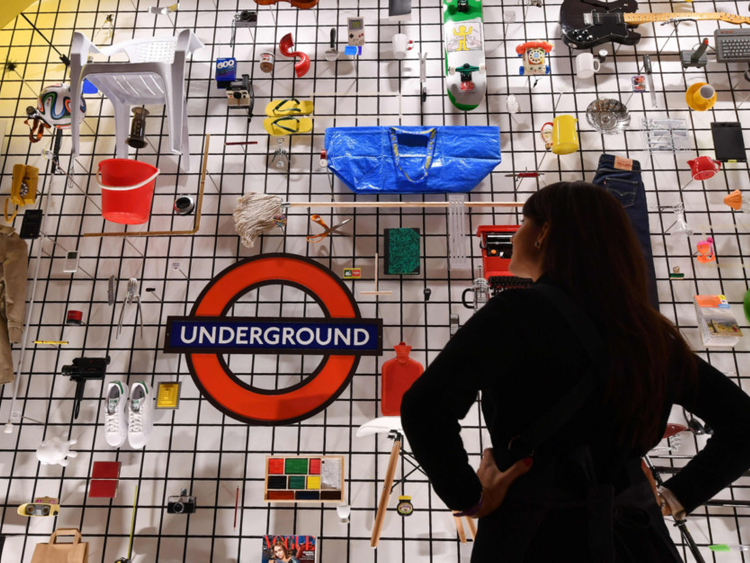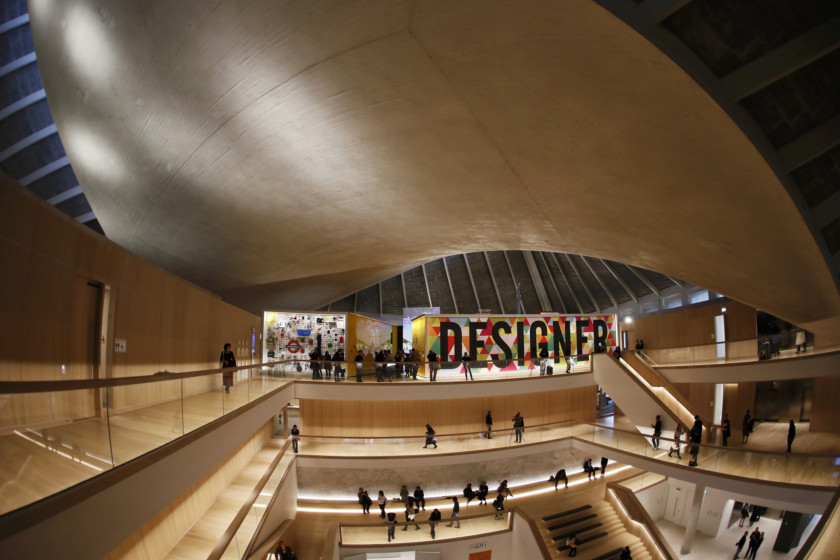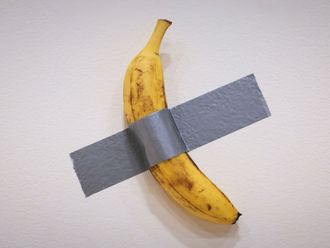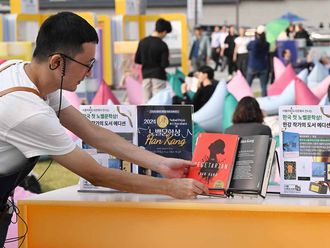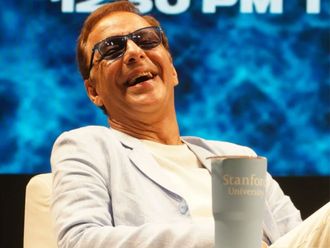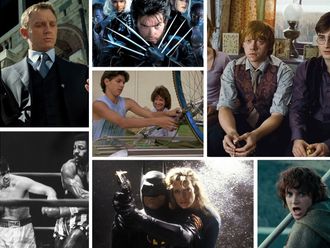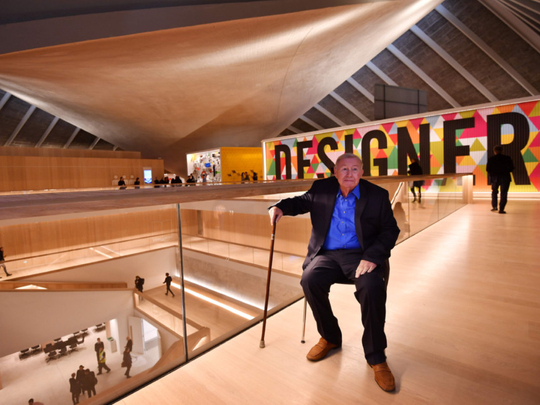
It’s hard to see what the fuss is about. Literally. From the street, London’s new Design Museum is tucked away behind blocks of white, rather clinical, luxury flats. There’s just a glimpse of what looks like a large wigwam floating on a blue, glazed base.
There is a better view from behind the building, a few hundred metres into Holland Park, when more of the roof comes into view. The technical term for it is a hyperbolic paraboloid, but the swoops and curves of its creator’s daring flight of fancy are better described as a manta ray, a circus tent or even an extravagant version of a cardinal’s hat.
No wonder deputy head of the museum, Alice Black, says the roof is the kingpin of the collection.
Such an original concept is an entirely appropriate setting for what Sir Terence Conran, founder of the first Design Museum, described as the “greatest moment of my career”. Quite something from the man who has been the guru of taste, style and good food in the UK since the 1960s.
It has taken 10 years and £83 million (Dh378 million) to bring that moment to reality with the opening of the new museum in Kensington High Street, west London, last month.
The museum is on the site of the Commonwealth Institute, which was built in 1962 as a venue to bring together the many nations of post-imperial Britain where they could share their heritage with exhibitions, meetings and cultural events.
Designed by modernist architect Robert Matthew, the original had a low brickwork plinth clad in blue-grey glazing similar to today’s version while the complex roof was made with 25 tonnes of copper donated by a mining company in what was Northern Rhodesia, now Zambia.
At the time the building was hailed as symbol of optimism and progress but it lost relevance as the Commonwealth itself, a loose hegemony of the old Empire, lost its impetus as a social and political force. The Institute finally closed in 2002 and was destined for demolition only to be spared by English Heritage (now Historic England), the charity that manages the country’s historic buildings, which rated it as one of London’s most important postwar buildings and awarded it a Grade Two listing.
Reinier de Graaf of architecture company OMA, which is responsible for the overall footprint of the new flats and the museum, says, “It was a fantastic building, but when we came to look at it was dead. Listed but unloved.” In fact, not unlike Kensington High Street itself, which has long lost the allure of the days when it boasted some of the city’s best known department stores and enjoyed a frisson of glamour when fashion trailblazer Biba opened there in the 1960s.
Developers Chelsfield suggested the abandoned building could be part of a deal in which the firm gave over the building to the Design Museum on a 175-year lease for a peppercorn rent in return for being allowed to build three blocks of flats on the forecourt, along with £20 million in kind as contribution to its renovation.
It was an offer the museum could not refuse. The original version started life in a basement in the Victoria and Albert Museum and in 1989 moved into a former banana warehouse near Tower Bridge, east London. It was small and cramped — not enough room for a permanent exhibition, for example — and a complete contrast to the wide open spaces of the new building which has tripled the size of the museum to almost 10,000 square metres.
The challenge for the architect of the building, John Pawson, was how to work within the strictures of regulations that come with a Historic England listing. Obviously the roof had to stay, but inside there used to be several floors which radiated around a central circular atrium with spoke-like stairs leading to it. Each floor was cluttered with display areas that were open to the ceiling.
That would not appeal to a cool, clean minimalist designer as Pawson, who specialises in austere but beautiful projects such as the Cistercian abbey of Novy Dvur in the Czech Republic.
The atrium is a now dramatic open space. Instead of a myriad stairs, the visitor makes a stately progress up a wide staircase, along landings and up two further flights of stairs. There’s something of the promenade about it.
Everything is in white with pale oak stairs and balustrades and one wall in marble, taken from the floor of the old Imperial Institute in South Kensington, which was knocked down in 1965.
On each of the three floors are rooms for libraries, workshops and a restaurant, though many of the rooms impede the view of the complex interplay of the ceiling and the huge leaping salmon of an arch which curves across the interior.
A few tokens of the old building remain, including a map of the world showing the countries of the Commonwealth at the time picked out in beige, rather than imperial red, and modernist stained glass windows.
The most eye-catching in all this calming white is a bright multicoloured sign, like an ever-changing advertising billboard, which spells out the museum’s mission statement — Designer, Maker, User.
Curator Justin McGuirk says the museum wants to create exhibitions that provoke a broader sense of design’s possibilities, processes and impacts. “We’re saying that design is actually a way of looking at the world generally and that design has a role to play in bigger issues that go beyond objects.”
He makes the point that questions of sustainability and climate change are now central to our understanding of mass-produced objects, just as anxiety over the spread of surveillance affects our understanding of digital technology.
To enhance those ambitions, the museum has, for the first time, enough space for designers in residence to show their work as well as permanent and temporary exhibitions — all of which, it is hoped, will increase visitor numbers from the current 250,000 to more than 650,000 each year.
The permanent display features a wall graphic that tells the history of design in 50 key moments, from one of the world’s first factories opened by Josiah Wedgwood, the pottery maestro, to the Great Exhibition of London in 1851, when six million flocked to see the latest in art, textiles and furniture to 2012 with the invention by the MarketBot company of the 3D printer.
A six metre-long wall of 250 objects nominated by the public supports Italian architect Ernesto Rogers’s suggestion that design encapsulates everything, from the spoon to the city, or the boast by the great American industrial designer Raymond Loewy, who declared that his expertise ranged “from a lipstick to a steamship”.
Deyan Sudjic, director of the Design Museum, says, “The museum’s collection is not a chronological timeline or simply a collection of design’s greatest hits. We are investigating what objects and products mean, and demonstrating that the story behind how they are made is as important as their final appearance. It’s an exploration of design from the points of view of the user and the maker, as well as the designer behind it.”
The people’s choice includes Converse trainers, London mayor Sadiq Khan chose the London Underground roundel, there’s a bucket and mop, an Olivetti typewriter, a Bible and a can of Coke.
The exhibition traces the evolution of technology with early laptops, cash registers, speakers and early radios and is divided into three sections: Designer, Maker and User. In the Designer section, architect Richard Rodgers is represented by the Pompidou Centre in Paris, there are road signs designed in the 1960s by Margaret Calvert and still in use and a life-size model of a new underground train. In the Maker section, the 2012 Olympic torch and the Model T Ford and in User, the Walkman, Louboutin high heels and Yves Saint Laurent’s Le Smoking Tuxedo.
How quickly such inventions, so radical and chic in their day, become quaint and outdated.
The opening temporary exhibition entitled “Fear and Love: Reactions to a Complex World” is given over to commissioned installations by designers and architects dealing with contemporary topics. “I want to get away from the idea of a design museum being a place where you put objects on plinths. I want a more experiential format that allows you to think about issues, ideas and experiences,” says McGuirk.
The show includes yurts that have been designed to help a housing problem caused by the huge number of Mongolian nomads who move to the capital Ulan Bator and, one of the odder contributions, grotesque plastic death masks made from 3D printing technology.
In complete contrast, Mimus the robot, like a questing puppy, reacts to movement beyond its glass enclosure in ways that could be interpreted as friendly, or hostile.
Designer Madeleine Gannon, from Pittsburgh, USA, is playing on the fear that robots will steal our jobs — five million of them in the next five years, according to the World Economic Forum. However, she says, “I wanted to show that robots could be a companion species. We might overcome our anxiety by establishing a bond with the machines.”
The new museum aims to be the best in the world. Competition for that top slot has seen the launch of new design museums in Tokyo, Barcelona and Canberra. The Cooper Hewitt, Smithsonian Design Museum in New York reopened after a three-year break at the end of 2014, but as Conran said at the opening: “This is the best design museum in the world. China or Singapore might build a bigger one, but it won’t be better ... The importance of design to the economy should be truly appreciated. I hope the government understands that design is important to the economy and should be brought in from the margins to improve the quality of life. Every manufacturer should have a designer on board. If it can have accountants, it can have designers.”
Richard Holledge is a writer based in London.



